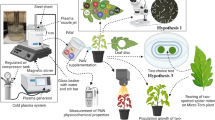Abstract
Conidia ofUncinula necator inoculated on vine leaf disks were exposed to different irradiation conditions during various combinations of irradiation periods. In controlled experiments at constant leaf temperature spore germination and mycelial growth were negatively affected by the UV B doses, irrespective of the exposition duration. In semi-controlled condition experiments, conidia were exposed to shaded, sunny and sunny without UV B radiation conditions. Shaded conditions were always more favourable to spore germination and mycelial growth than sunny conditions. Under two different ranges of temperature (20–24 and 26–31 °C for shaded conditions), the effect of radiation on germination and mycelial growth differed. Thus, the effect of radiation on spore germination and mycelial growth seems to be affected by temperature. In general, radiation effects increased as the number of exposition periods increased, indicating that both spore germination and mycelial growth were reduced, but not totally stopped by the different exposures. Germination was most affected by exposures applied just after inoculation, whereas mycelial growth was most affected by exposures applied one day after inoculation. These results indicate that radiation is an important factor to consider for a better understanding of the relationships between climate and grape powdery mildew epidemics.
Similar content being viewed by others
References
Bulit J and Lafon R (1978) Powdery mildew of the vine. In: Spencer DM (ed) The Powdery Mildew (pp. 525–548) Academic Press, New York
Chellemi DO and Marois JJ (1992) Influence of leaf removal, fungicide applications, and fruit maturity on incidence and severity of grape powdery mildew. Am J Enol Vitic 43: 53–57
Delp CJ (1954) Effect of temperature and humidity on the grape powdery mildew fungus. Phytopathology 44: 618–626
Fargues J, Rougier M, Goujet R and Itier B (1988) Effet du rayonnement solaire sur la persistance des conidiospores de l'hyphomycète entomopathogène,Nomuraea rileyi, à la surface d'un couvert végétal. Entomophaga 33: 357–370
Fargues J, Rougier M, Goujet R, Itier B and Coustere C (1989) Microclimatic studies of the persistence ofNomuraea rileyi. IOBC/WPRS meeting: microbial control of Weevils and Environnemental persistence of pathogens and nematodes, Versailles. Bull OILB/SROP 12: 64–65
Finckh MR, Chavez, AQ, Dai Q and Teng PS (1995) Effects of enhanced UV-B radiation on the growth of rice and its susceptibility to rice blast under glasshouse conditions. Agric Ecosystems and Environ 52: 223–233
Heintz C (1988) Etude du processus d'infection de la vigne par l'oïdium et des mécanismes de défense chez les différentes cépages. Ph.D. thesis. Université de Bordeaux II
Jagger J (1958) Photoreactivation. Bacteriol Rev 22: 99–142
Leach CM (1971) A practical guide to the effects of visible and ultraviolet light on fungi. Methods Microbiol 4: 609–664
Maddisson AC and Manners JG (1972) Sunlight and viability of cereal rust uredospores. Trans Brit Myc Soc 59: 429–443
Maddisson AC and Manners JG (1973) Lethal effects of artificial ultraviolet radiation on cereal rust uredospores. Trans Brit Myc Soc 60: 471–494
Manners JG (1966) Assessment of germination. In: Madelin (ed) The Fungus Spore (pp. 165–173) London
Murashige T and Skoog F (1962) A revised medium for rapid growth and bioassays with tobacco tissue culture. Physiol Plant 15: 473–497
Oku H, Hatamoto M, Ouchi, S, and Fuji S (1975) Effect of temperature and humidity on the development of powdery mildew of grapevine. Sci Rep Fac Agric Okayama Univ 45: 16–20
Orth AB, Teramura AH and Sisler HD (1990) Effects of ultraviolet-B radiation on fungal disease development inCucumis sativus. Am J Bot 77: 1188–1192
Pearson RC and Goheen AC (1988) Compendium of grape diseases. The American Phytopathological Society. APS Press
Rotem J, Wooding B and Aylor DE (1985) The role of solar radiation, especially ultraviolet, in the mortality of fungal spores. Phytopathology 75: 510–514
Rougier M, Fargues J, Goujet R, and Smits N (1993) Photic effect of solar U.V. radiations on the survival of entomopathogenic hyphomycete. In: C Varlet Grancher and R Bonhomme (eds) Crop Structure and Light Microclimate: Characterisation and Applications (pp. 453–458) Coll. Science Update, INRA, Paris
Rougier M, Fargues J, Goujet R, Itier B and Benateau S (1994) Mise au point d'un dispositif d'étude des effets du rayonnement sur la persistance des microorganismes pathogènes. Agron 14: 673–681
Runeckles VC and Krupa SV (1994) The impact of UV B radiation and ozone on terrestrial vegetation. Environ Pollut 83: 191–213
SAS Institute Inc (1988) SAS/STAT User's Guide, Release 6.03 Edition. SAS Institute, Cary, NC 27513. 1029 pp
Smits N (1992) Approche de la modélisation des effets du rayonnement solaire sur la persistance des spores quiescentes de l'hyphomycète entomopathogènePaecilomyces fumosoroseus (Wise) Brown and Smith. Ph.D. thesis. Université de Lyon I
Smits N, Rougier M, Goujet R, Bonhomme R and Fargues J (1992) Effect of solar radiation on the persistence of quiescent conidia of the hyphomycetePaecilomyces fumosoroseus. Proc Soc Invertebr Pathol Coll, Heidelberg, 118 pp
Steva H and Clerjeau M (1990) Cross-resistance to sterol biosynthesis inhibitor fungicides in strains ofUncinula necator isolated in France and Portugal. Med Fac Landbouww Rijksuniv Gent 55: 983–988
Steva H (1994) Evaluating anti-resistance strategies for control ofUncinula necator. In: Heaney S, Slawson D, Hollomon, DW, Smith, N, Russell, PE, and Parry DW (eds) Fungicide Resistance BCPC Monograph n∘ 60 (pp. 59–66) Major Print Ltd Eds., Nottingham
Stevenson RE and Pennypacker SP (1988) Effect of radiation, temperature, and moisture on conidial germinationof Alternaria solani. Phytopathology 78: 926–930
Toma N (1978) Orientari noi in combaterea fainarii vitei de vie-Uncinulanecator (Schw.) Burr. Horticultura 4: 34–38
Weltzien-Stenzel M (1959) Recherches sur la biologie de la germination des conidiesd'Uncinula necator (Schw.). Burr Hoefchen-Briefe 12: 29–52
Yossifovitch M (1923) Contribution à l'étude de l'oïdium de la vigne et de son traitement. Ph.D. thesis. Faculté des Sciences de Toulouse
Author information
Authors and Affiliations
Rights and permissions
About this article
Cite this article
Willocquet, L., Colombet, D., Rougier, M. et al. Effects of radiation, especially ultraviolet B, on conidial germination and mycelial growth of grape powdery mildew. Eur J Plant Pathol 102, 441–449 (1996). https://doi.org/10.1007/BF01877138
Accepted:
Issue Date:
DOI: https://doi.org/10.1007/BF01877138




